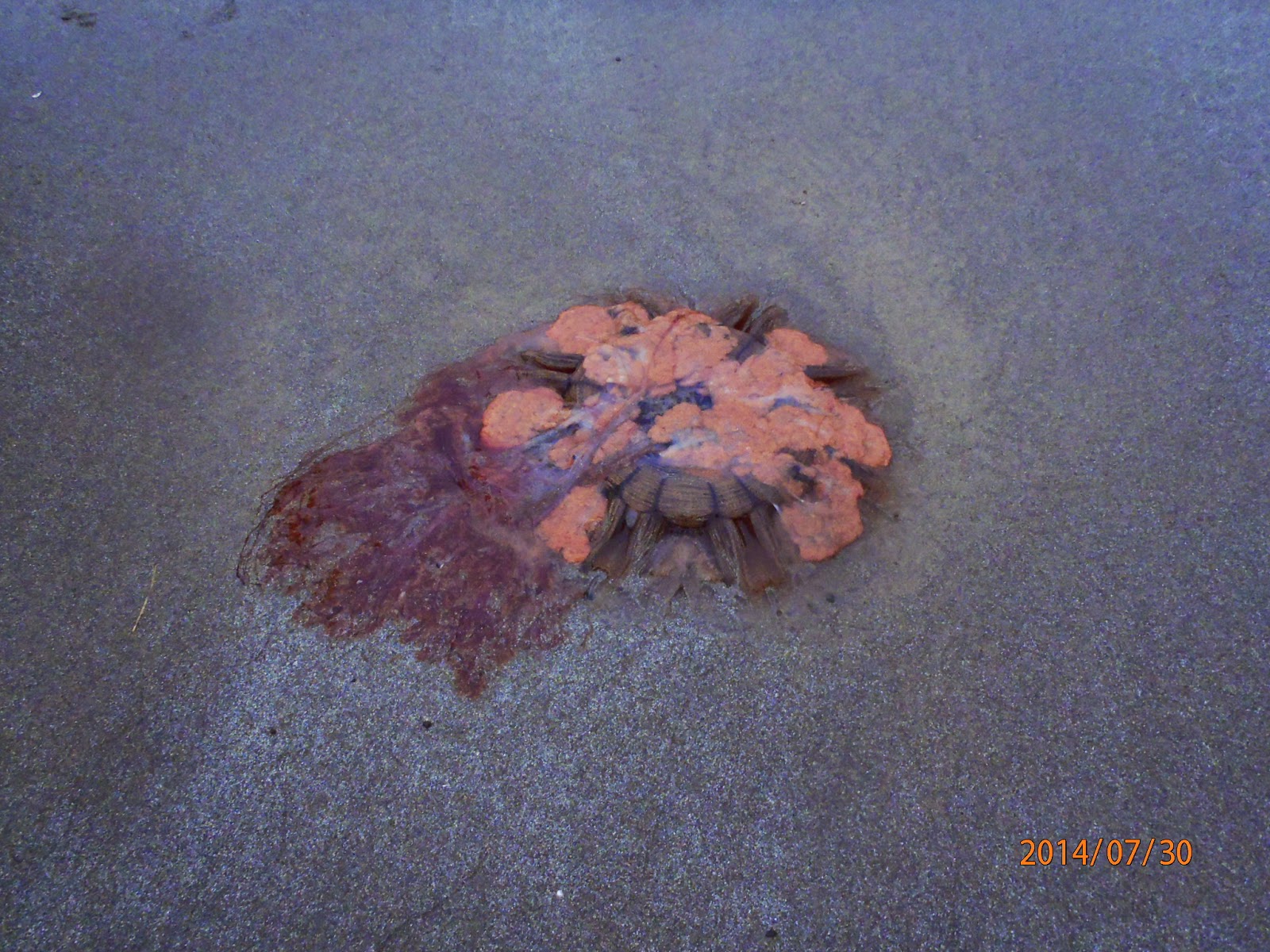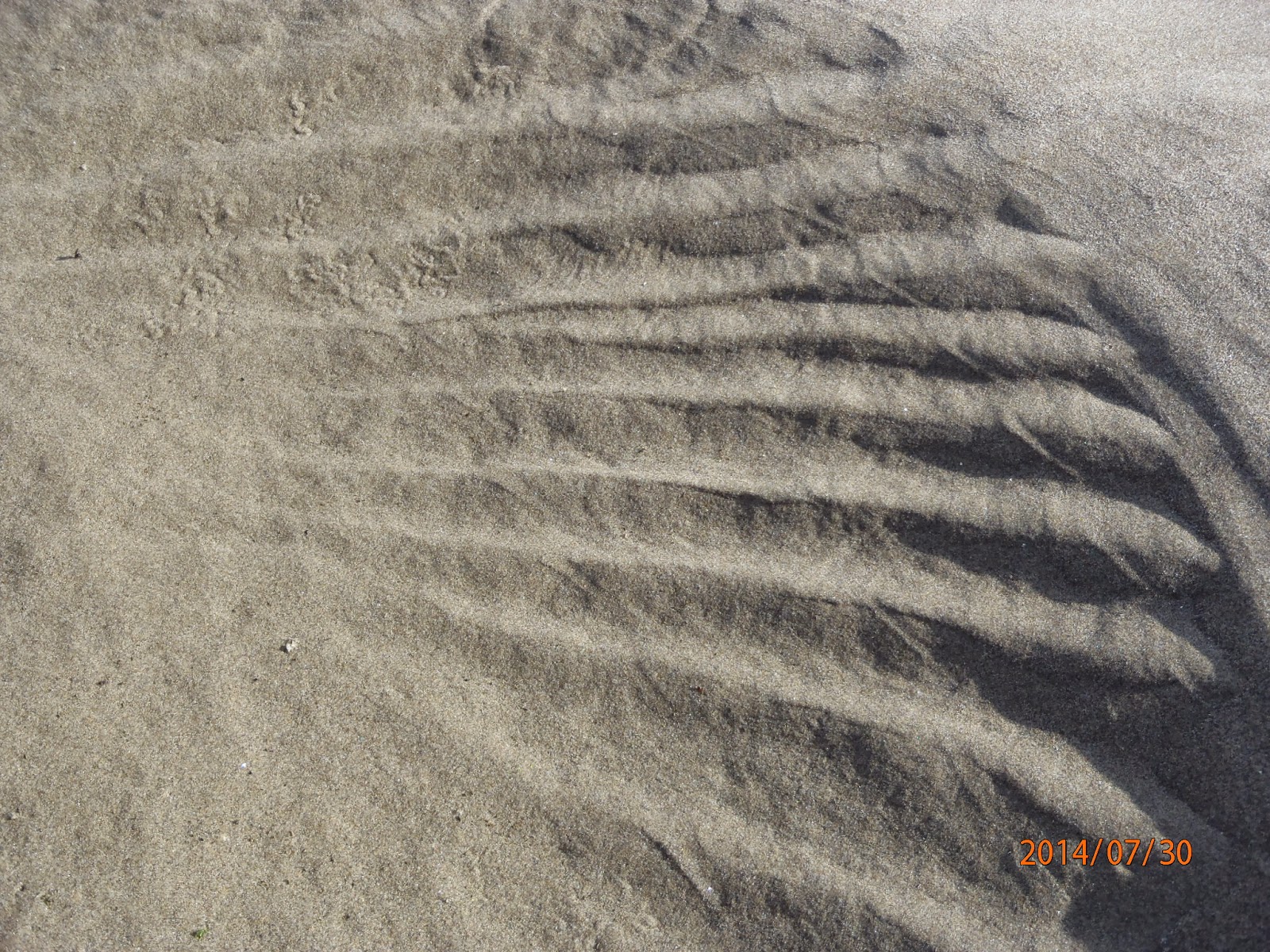July 28th - August 3rd 2014
Daily Low Tides
Monday, July 28th
Low tide: 2.0' @ 8:28 PM
Tuesday, July 29th
Low tide: -0.1' @ 8:52 AM
Wednesday, July 30th
Low tide: 0.2' @ 9:20 AM
Thursday, July 31st
Low tide: 0.5 @ 9:48 AM
Friday, August 1st
Low tide: 0.9' @ 10:18 AM
Saturday, August 2nd
Low tide: 1.3' @ 10:54 AM
Sunday, August 3rd
Low tide: 1.9' @ 11:38 AM
Notes from the week
The unusually large beaching event of purple hydroid "jellyfish" known as Velella velella continued this week. A couple of other maritime creatures visited the shore as well, including a lion's mane jellyfish on Wednesday and a juvenile harbor seal on Thursday.
In addition to these animals, the waves brought us some beautiful sand patterns.
On Friday, we were also lucky enough to witness a hermit crab seek out a new shell (see below) and another female hermit crab carrying bright red eggs.
A group of 45 high school students visited us that day, as did another group of 23 adults.
Creature Highlights
Let's talk about hermit crabs!
We'll leave a discussion of crab classification to the experts, but it's worth noting that hermits are part of the group "Anomura" within the crustaceans (themselves a type of arthropod, along with insects and spiders). "True" crabs like the Dungeness are a different type of crustacean, a group known as the "Brachyura." The differences between the two groups are somewhat subtle, and mainly depend on the architecture of the legs and abdomen.
But any schoolchild will tell you what really makes a hermit crab stand out: it doesn't have its own shell!
This unusual but highly successfully strategy makes hermit crabs a cosmopolitan group consisting of many species-- including some that live on land! (What do they use as housing? Pieces of bamboo!) The adaptation to this nomadic, squatter-like existence begins early on in the hermit crab's life cycle, when the larva begins to develop asymmetrically in order to better occupy twisted snail shells in the future.
Hermits are both opportunistic and selective when it comes to choosing a new shell to live in. At Haystack Rock, we often seen them occupying black turban and dogwinkle shells. Once it moves in, the hermit will sometimes decorate its new shell with sea anemones, whose stinging, sticky tentacles ward off predators like crabs and octopuses.
Hermits are also opportunistic feeders, usually living off of the detritus- bits of dead animals-- left in the tidepools, although some have a specialized method of filter feeding, and one or two species is an active predator. Mostly, though, they are scavengers-- a key role in the ecology of the tidepool.
The humble hermit crab serves as a reminder that even the animals we're used to seeing all the time have complex and interesting stories to tell. We tend to focus our attention on creatures that are rare and mysterious, but it's worth taking a closer look at the more commonplace animals from time to time.
Birds
Brusca, R.C. and Brusca, G.J. (eds.) Invertebrates. 2nd ed. Sunderland, MA: Sinauer Associates, Inc. 2003.
Lamb, A. and Hanby, B. Marine Life of the Pacific Northwest: A Photographic Encyclopeida of Invertebrates, Seaweeds and Selected Fishes. Maderia Park B.C. Harbour Publishing, 2005.
Hazlett, B. A. The behavioral ecology of hermit crabs. Ann. Rev. Ecol. Syst. 12: 1-22. 1981.
http://www.theguardian.com/world/2014/jul/31/us-west-coast-jellyfish-velella. Accessed 8/10/14.
Monday, July 28th
Low tide: 2.0' @ 8:28 PM
Tuesday, July 29th
Low tide: -0.1' @ 8:52 AM
Wednesday, July 30th
Low tide: 0.2' @ 9:20 AM
Thursday, July 31st
Low tide: 0.5 @ 9:48 AM
Friday, August 1st
Low tide: 0.9' @ 10:18 AM
Saturday, August 2nd
Low tide: 1.3' @ 10:54 AM
Sunday, August 3rd
Low tide: 1.9' @ 11:38 AM
Notes from the week
The unusually large beaching event of purple hydroid "jellyfish" known as Velella velella continued this week. A couple of other maritime creatures visited the shore as well, including a lion's mane jellyfish on Wednesday and a juvenile harbor seal on Thursday.
Lion's mane jellyfish washed up on the sand.
Sort of an "art deco" sand pattern.
Sand patterns can be like a Rorschach inkblot test. One volunteer saw a scallop shell here. What do you see?
On Friday, we were also lucky enough to witness a hermit crab seek out a new shell (see below) and another female hermit crab carrying bright red eggs.
A group of 45 high school students visited us that day, as did another group of 23 adults.
Creature Highlights
Let's talk about hermit crabs!
We'll leave a discussion of crab classification to the experts, but it's worth noting that hermits are part of the group "Anomura" within the crustaceans (themselves a type of arthropod, along with insects and spiders). "True" crabs like the Dungeness are a different type of crustacean, a group known as the "Brachyura." The differences between the two groups are somewhat subtle, and mainly depend on the architecture of the legs and abdomen.
But any schoolchild will tell you what really makes a hermit crab stand out: it doesn't have its own shell!
A hermit crab photographed while on the hunt for a new shell. HRAP staff observed this animal leave its current shell for a larger one, only to find that the new shell was already occupied. It retreated back to its original shell. Better luck next time!
This unusual but highly successfully strategy makes hermit crabs a cosmopolitan group consisting of many species-- including some that live on land! (What do they use as housing? Pieces of bamboo!) The adaptation to this nomadic, squatter-like existence begins early on in the hermit crab's life cycle, when the larva begins to develop asymmetrically in order to better occupy twisted snail shells in the future.
Hermits are both opportunistic and selective when it comes to choosing a new shell to live in. At Haystack Rock, we often seen them occupying black turban and dogwinkle shells. Once it moves in, the hermit will sometimes decorate its new shell with sea anemones, whose stinging, sticky tentacles ward off predators like crabs and octopuses.
Hermits are also opportunistic feeders, usually living off of the detritus- bits of dead animals-- left in the tidepools, although some have a specialized method of filter feeding, and one or two species is an active predator. Mostly, though, they are scavengers-- a key role in the ecology of the tidepool.
The humble hermit crab serves as a reminder that even the animals we're used to seeing all the time have complex and interesting stories to tell. We tend to focus our attention on creatures that are rare and mysterious, but it's worth taking a closer look at the more commonplace animals from time to time.
Birds
- Black oystercatcher (Haematopus bachmani).
- Western gull (Larus occidentalis) -juveniles seen hopping about, practicing for flight
- Tufted puffin (Fratercula cirrhata)
- Bald eagle (Haliaeetus leucocephalus)
- Purple sails (Velella velella)
- Dungeness crabs (Cancer magister) -seen mating
- Sea urchin (Strongylocentrotus purpuratus)
- Lion's mane jellyfish (Cyanea capillata)
- hermit crabs
- Harbor seal (Phoca vitulina) pup
Brusca, R.C. and Brusca, G.J. (eds.) Invertebrates. 2nd ed. Sunderland, MA: Sinauer Associates, Inc. 2003.
Lamb, A. and Hanby, B. Marine Life of the Pacific Northwest: A Photographic Encyclopeida of Invertebrates, Seaweeds and Selected Fishes. Maderia Park B.C. Harbour Publishing, 2005.
Hazlett, B. A. The behavioral ecology of hermit crabs. Ann. Rev. Ecol. Syst. 12: 1-22. 1981.
http://www.theguardian.com/world/2014/jul/31/us-west-coast-jellyfish-velella. Accessed 8/10/14.








Comments
Post a Comment